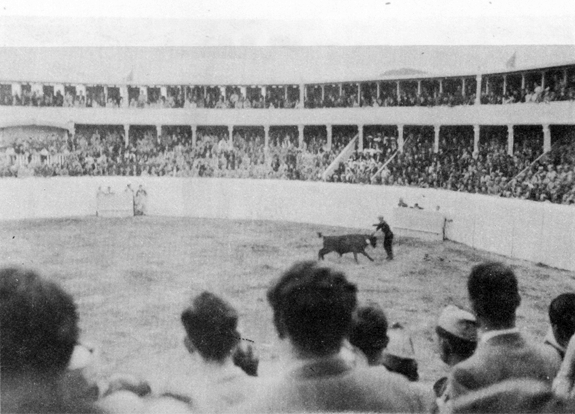The Azores - Mission accomplished |
|
It was not all construction work for the men of the 801st Engineer Battalion during 1944. Starting on 17 April truck convoys began taking men on liberty the sixteen miles to Angra. Vinho was drunk, Swiss watches were purchased, sights were seen, and the men experienced life in a foreign land - including, in the words of the official history, the "ever-present odors of life in a city with no sanitary system." For the rest of the battalion's stay on Terceira daily runs were made to provide the men with a break in the monotony of camp life.

Men of the 801st attend a bullfight in Angra arena
Life gradually got easier as more infrastructure was completed and the weather moderated with the coming of summer. One luxury was the daily delivery of a current newspaper, less than a day old, brought in by bomber or transport crews arriving from the States.
On 14 October 1944 a hurricane struck the Azores. Many tents were blown down, notably those used for supply and S-3 offices. But herculean effort saved the majority of the camp from damage as men drove additional stakes and physically held onto guy ropes during the wind and pounding rains. The 801st would have the probably unique distinction of any World War II unit of experiencing firsthand both an Atlantic hurricane and a Pacific typhoon.
As critical projects such as the runways and the tank farm came to completion, it was announced at the end of October that fifteen-day leaves plus travel time by air to the U.S. would begin to be granted. Four per cent of the men would be allowed to go at a time, the names being drawn by lottery. The first group left at the beginning of November but they had not even returned before it became apparent that no more groups would be sent. Their mission accomplished, the 801st would probably be leaving the Azores before too much more time went by.

Click map to see larger version showing the strategic location of the Azores and how it drastically cut the air route to Africa and Europe |
 |
The construction of the Azores air base accomplished exactly what high command intended. Thousands of miles were cut from the southern transport route for combat and transport aircraft heading for the war zones. A steady stream of airplanes would arrive each day, landing every few minutes all day long and for a few months making Lagens Field one of the busiest airports in the world. Planes could be serviced overnight while crews could relax and recover from their long ocean flight in comfortable barracks, get some hot chow, and even catch a movie. And in the morning the parade would start again, streaming over the eastern horizon to bring Germany to its knees.
By June of 1945 8,689 Allied aircraft were to use Lagens Field as a steping stone to North Africa, England, and France, over 6,700 of those in the last twelve months of the war. This included over 1,200 heavy bombers joining the U.S. Fifth and Eighth Air Forces. Over 30,000 medical air evacuations returned to the United States through the base. |
As is often the case with the Army, the November prediction of an imminent departure from the Azores was overly optimistic. Another Christmas would pass and a new year would be well underway before the 801st took leave of Lagens Field. But that was o.k. They were going to be going in the right direction.
Next: Home for 30 days >>
|
